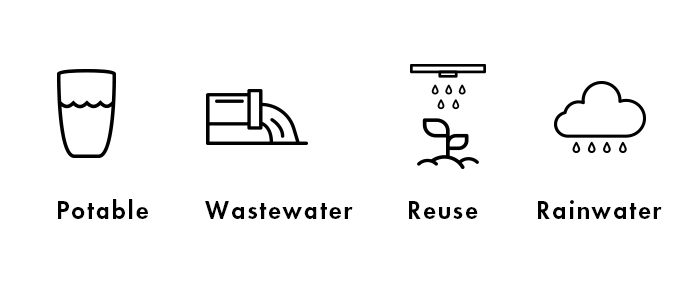Water is used everywhere, from agricultural and industrial to residential and healthcare settings and beyond. Whatever the specific application – whether it’s potable water, wastewater, reuse water, or rainwater – safety is paramount. Here is an introduction to water disinfection.  There are many ways to make water safe for use, including various processes for filtration (nano, ultra, and reverse osmosis) and disinfection (chemical and non-chemical). The process or combination of processes used depends on factors, such as the initial water quality, intended end use, logistical and economic considerations.
There are many ways to make water safe for use, including various processes for filtration (nano, ultra, and reverse osmosis) and disinfection (chemical and non-chemical). The process or combination of processes used depends on factors, such as the initial water quality, intended end use, logistical and economic considerations.
In this post, we focus on ultraviolet (UV) water disinfection, providing an overview of how it works and how it is evolving.
The water disinfection landscape
In general, there are two main categories of water disinfection technology:
1. Chemical technologies, which include chlorine, ozone, and peracetic acid
2. Non-chemical technologies, which include UV disinfection
 Each technology has a unique set of advantages and disadvantages. For example, chemical disinfection using chlorine is highly reliable and inexpensive, but it poses safety risks in the handling of chlorine and the creating toxic byproducts.
Each technology has a unique set of advantages and disadvantages. For example, chemical disinfection using chlorine is highly reliable and inexpensive, but it poses safety risks in the handling of chlorine and the creating toxic byproducts.
When deciding which technology is best for an application, engineers typically take into consideration a range of factors. Some of those factors include requirements for biocidal efficiency, practicality, reliability, cost, environmental impact and occupational health and safety.
Harnessing the power of UV light
UV water disinfection harnesses the germicidal power of short-wave UV light, specifically at the 254nm wavelength, to damage the DNA of cells and viruses. Applying UV light at this specific wavelength to water renders any microorganisms sterile, thereby disinfecting the water.
The first use of UV water disinfection technology was in 1910. Since then, the use of UV systems has grown as the technology has evolved along with scientists’ understanding of how UV light combats waterborne threats.
Compared to chemical disinfection technologies, non-chemical UV disinfection offers several key benefits in terms of safety and efficacy, including:
- Fast-acting, triggering a reaction almost instantly
- No disinfection by-products
- Safe and chemical-free, avoiding the handling and disposal hazards associated with chemicals
- Environmentally responsible technology
- Does not alter water chemistry and its constituents, such as pH, taste, odour, colour, etc.
- Proven and trusted
Different technologies for UV water disinfection
Since that first application, the sophistication and capabilities of UV water disinfection technology have grown exponentially. While manufacturers offer endless options for UV water disinfection systems, they can all be grouped into two main categories:
- Light-in-a-pipe systems. In these systems, pressurized water is exposed to 254nm UV light as it flows through a quartz tube. Light-in-a-pipe systems are advantageous in that they offer greater control over water conditions within the system, like preventing exposure to airborne pathogens. However, they can be costlier to operate given increased energy requirements and maintenance costs.
- Channel systems. In these systems, non-pressurized water is exposed to 254 nm UV light as it flows through an open channel. Channel systems are often used to disinfect large water streams, especially wastewater streams, as they can offer lower operation and maintenance costs. However, channel systems are also more vulnerable to airborne pathogens due to their open nature.
As both types of systems have advantages and disadvantages, it’s important for engineers to understand their options to find the best fit for their project.

Making water safer with better UV technology
UV systems are already a safe and reliable solution for disinfecting potable water, wastewater, reuse water, and rainwater, only becoming better with continual advances in technology.
Here are a few of the ways in which UV water disinfection technology is becoming smarter and more effective:
- UV dose consistency. Maintaining a consistent UV dose ensures the water flowing through a UV system meets the minimum requirements for safe disinfection. Advances in lamp technology allow lamps to be calibrated at a higher intensity initially to maintain the minimum required intensity until the end of their lifespan.
- Real-time monitoring. UV systems typically have sensors to indicate when performance falls below minimum thresholds. However, when sensors are poorly calibrated or the cause of an alarm is not clear, it can be a nuisance. Fortunately, smarter sensors and remote real-time monitoring are continually improving reliability while reducing maintenance requirements.
- 360-degree coverage. Suspended and dissolved solids in water can cause shadowing within a UV disinfection system allowing pathogens to pass through. This challenge is being overcome with smarter system design, such as using dual lamps and reflectors to provide 360-degree UV light coverage that attacks pathogens from all angles.
With some countries actively shifting away from chemical disinfection, due to health and safety concerns, demand for UV water disinfection is growing. Understanding UV water disinfection is becoming increasingly important for engineers around the world.

